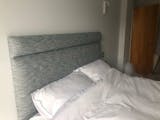Sleep plays an important role in both physical and mental wellbeing. Without adequate sleep, you could find yourself feeling irritable and stressed, and you may even underperform at work. It’s therefore vital to do everything you can to ensure that you get a good night’s sleep - and this is where high quality mattresses come into the equation. If you’re currently having to contend with a sagging mattress, you’ll know that bedtime isn’t particularly fun. Sagging mattresses cause back pain, neck pain and interfere with quality of sleep. If your mattress is cheap, there is little that can be done to rectify the problem without replacing your existing setup. So what causes a mattress to sag and how can you put it right?
What causes a mattress to sag?
Sagging is usually the result of typical wear-and-tear of the mattress. The materials used to construct mattresses tend to become softer and less bouncy over time. This is due to significant pressure being placed on them every night - after all, we spend approximately one-third of our lives sleeping, so it should come as no surprise that over a period of months or years, the foam materials in mattresses tend to break down and offer less resistance and support.
Innerspring and hybrid mattresses are the most common candidates for mattress sagging. These mattresses contain metal coils which have a tendency to lose tension over time, while the additional foam comfort layers will soften and lead to less rigid support in areas which are most exposed to pressure.
The main pressure points for mattresses are where the hips and shoulders lie. However, your sleeping arrangements could also impact upon your mattress in other places.

For example, if you have a partner and both of you tend to ‘spoon’ in the centre of the bed, it is likely that the centre of your mattress will begin to sag first. If you prefer to each stay to your own individual sides of the bed, it’s likely that the middle of the mattress will experience the least sagging, with one or both sides becoming uncomfortable over time. You should also consider the impact that pets might have on your bed.

If you have a large dog which likes to snuggle up at the end of the bed during the evening, chances are that the foot end of your mattress will show more wear-and-tear than you might expect. Regardless of which of these scenarios rings true, the end result of mattress sagging is that you will experience an uncomfortable night’s sleep. This can lead to fatigue, discomfort and irritability in the morning.
Can I fix my sagging mattress?
When it comes to mattress maintenance, prevention is usually better than the cure. In fact, if your mattress has already begun to sag to noticeable levels, it’s unlikely that you’re going to be able to perform any sort of long-term repair job on it. In this instance, it might be better to accept that your current mattress has seen better days, and prepare to look for new bespoke mattresses instead. With Endurance Beds, you can order made to measure mattresses that will ensure you get a comfortable night’s sleep instead of enduring the frustration of trying to catch forty winks on your existing model.
When you purchase a new mattress, you should consider implementing the following techniques to help prolong its lifespan:
1. Use a mattress topper
Mattress toppers are useful items which are placed on top of the mattress, as the name implies. They offer an additional layer of comfort and could also help to protect your mattress. A good mattress topper will provide a more even sleep surface, although it won’t fix the core problems caused by a sagging mattress.

2. Rotate your mattress
Regularly rotating your mattress by swapping the foot and head ends around could help to extend its lifespan. Doing so every six months is a good general rule of thumb. This can be beneficial even if your mattress has started sagging in one particular area, as it allows the more pressurised parts of the body to rest on areas of the mattress which have not yet started to sag.
However, before rotating your mattress you should check with the manufacturer to see whether it is recommended. Some specialist mattresses have been designed to withstand pressure in different areas, and if this is the case, rotating could do more harm than good.

3. Check the foundations of your bed
Believe it or not, a poorly-constructed or worn out bed could be contributing to your sagging mattress. Bed foundations with little or no support around the centre of the mattress can tend to cause issues, as can beds with slats. At times, slats can become loose or crack, often without the bed owner even noticing. If your bed is slatted, it can be a good idea to lift the mattress to check it for any issues from time to time.
If your bed frame has witnessed better days, it might be time to consider replacing it. At Endurance Beds, you’ll find a variety of wooden beds, wrought iron beds, cast iron beds and bespoke fabric beds to suit all tastes, budgets and requirements. Whether you just need a new frame or intend on outright replacing both your bed and mattress, there’s never been a better time to take a look at what’s on offer.

Product: Elvelyn Wrought Iron Bed in Black
Replacement mattresses made easy
No mattress is designed to last forever, and if your mattress is sagging and showing signs of wear-and-tear, it may simply be the case that it has reached the end of its useful life. Whatever the specifics of your situation, the friendly and experienced sleep specialists at Endurance Beds are here to guide you through the process of choosing the right mattresses to help you and your family get the best possible night’s sleep. We’re confident in our ability to help improve your sleep experience and deliver beds and mattresses that are built to last - and all at affordable prices, too.







